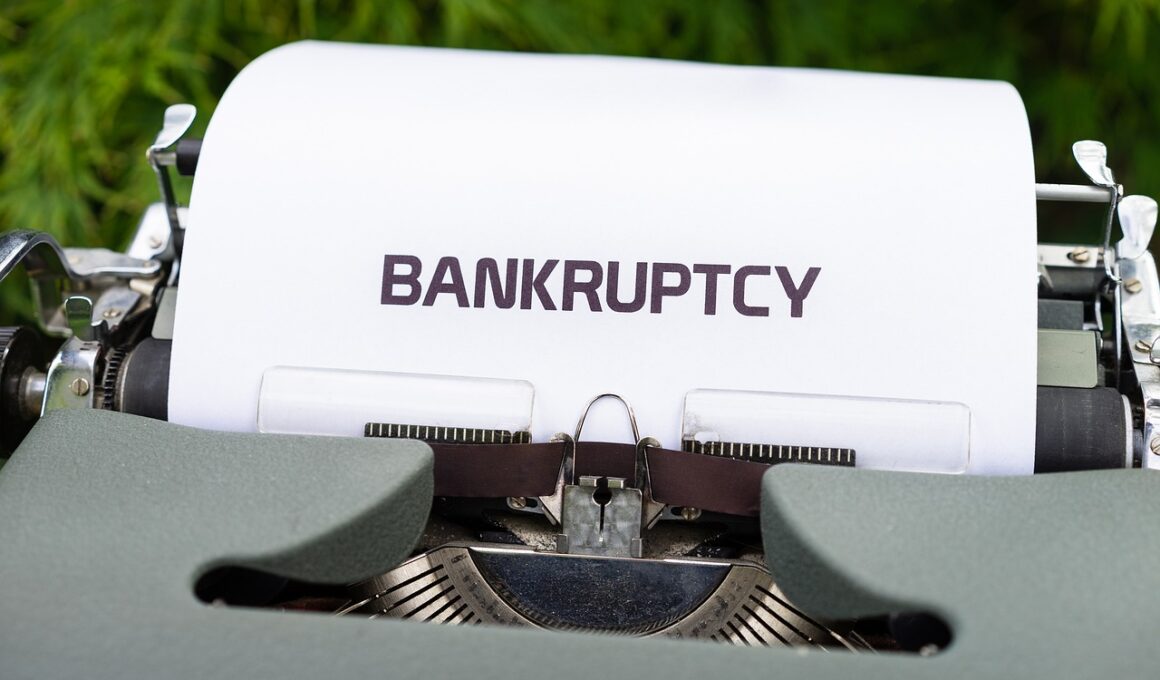The Importance of Leading Economic Indicators in Bankruptcy Forecasting
Bankruptcy forecasting plays a crucial role in understanding how economic indicators affect businesses. Leading economic indicators provide valuable insights into the future health of the economy, influencing companies nationwide. These indicators typically include metrics such as housing starts, manufacturing activity, and consumer confidence. Investors use this data to assess trends that may affect a business’s ability to remain solvent. By analyzing these indicators, stakeholders can develop a clearer picture of potential risks and opportunities in their investments. For instance, a rise in unemployment claims often signals an impending economic slowdown, which can lead to higher bankruptcy rates. Moreover, when consumers are less confident, they tend to spend less, impacting businesses revenue. This prediction ability is essential for creditors, investors, and policy makers who need to make informed decisions. Understanding the relationship between these indicators and bankruptcies can help financial institutions to manage risks effectively. Consequently, this foresight also aids in shaping economic policies that can support struggling businesses. Overall, leveraging leading economic indicators can help in anticipating critical shifts in the economic landscape and thus prevent potential bankruptcies.
Leading economic indicators are essential for identifying trends that may signal financial distress. These indicators help to gauge economic performance before it is fully apparent in the market. For example, if leading indicators suggest a declining economy, entrepreneurs may consider scaling back operations or reassessing their business strategies. Significant fluctuations in consumer spending or rising interest rates can be precursors to tougher financial times, hence understanding these signals allows companies to adapt proactively. Furthermore, evaluating trends over time provides deeper insights into cyclical patterns that could lead to financial challenges. Analysts often study employment rates, inventory levels, and business investment to predict economic downturns. Indeed, historical data showcasing past bankruptcies can reveal correlations with previously noted economic indicators. This historical perspective enriches the forecasting model, enhancing its reliability. Timely intervention can mitigate the risks of bankruptcy during troubling economic periods, protecting the investments of stakeholders. Tools linked to these indicators also facilitate strategic decision-making among business leaders. Hence, companies that stay aware of leading indicators are better positioned to maintain resilience amid economic fluctuations. The foresight provided by this analysis is invaluable in the competitive business environment.
Understanding Economic Indicator Cycles
The relationship between economic conditions and bankruptcies often follows a cyclical pattern. Typically, during economic expansions, businesses thrive, and bankruptcy rates decline significantly. However, when these expansions become unsustainable, economic contractions inevitably follow, leading to an increased rate of bankruptcy filings. This cycle is important for businesses when planning and strategizing. By monitoring leading economic indicators, firms can gain insights into when the economy may turn, allowing them to make informed decisions in anticipation of these shifts. For example, a significant decrease in the stock market can indicate lowered consumer spending projections. This insight helps to guide businesses toward managing their expenses and cash flow more effectively. Implementing a proactive approach, such as tightening credit policies and restructuring finances, becomes essential. Additionally, understanding how external factors, such as geopolitical events or regulatory changes, influence these cycles helps businesses to adapt strategies accordingly. Therefore, a clear focus on leading indicators enables companies to weather economic storms more effectively. Ultimately, understanding this cyclical relationship aids stakeholders in making educated strategic decisions that minimize bankruptcy risks for their enterprises.
Monitoring the relationship between external factors and bankruptcy risk is vital. Economic policies, global market trends, and trade tariffs can significantly impact financial health. These components can lead to shifts in consumer behavior and spending patterns, thus influencing bankruptcy rates. Businesses should remain aware of these dynamics to foresee changes in their markets, adapting their strategies to navigate potential financial turbulence. For instance, an increase in tariffs may lead to surging production costs, ultimately affecting profit margins. Companies with thin margins and high debt are particularly vulnerable in such scenarios. Therefore, evaluating the impact of trade policies and implementing strategic pricing can help mitigate risks. Moreover, sector-specific factors, such as technological advancements, also require constant monitoring. Industries experiencing rapid changes due to technology may find themselves vulnerable if they fail to innovate. Being aware of these leading economic indicators thus allows businesses to prepare for shocks and implement contingency plans. Additionally, financial analysts often utilize these indicators to determine valuation and investment viability, contributing to a holistic decision-making process. In conclusion, understanding the impact of external factors and leading economic indicators can significantly reduce bankruptcy risk.
The Role of Consumer Confidence
Consumer confidence is another leading indicator that influences bankruptcy rates. When consumers feel secure in their financial situation, spending typically increases, positively affecting overall demand for goods and services. However, fluctuating levels of consumer confidence can signal economic trouble ahead. Businesses should pay close attention to consumer sentiment surveys, which gauge how people perceive their financial futures. A significant drop in consumer confidence can indicate potential downturns, prompting companies to revise their sales forecasts and financial plans. For instance, in times of uncertainty, consumers might delay major purchases or reduce discretionary spending, affecting business revenues. Companies that react quickly to declining consumer confidence can optimize inventory levels and manage cash flow more effectively. Additionally, effective marketing and communication strategies can rebuild confidence, encouraging consumers to spend. Organizations may also explore strategic partnerships or innovative marketing campaigns to engage customers directly during challenging periods. Thus, understanding the dynamics of consumer confidence is crucial in bankruptcy forecasting, enabling businesses to take preventive measures ahead of time. Overall, it cements the connection between economic sentiment and the financial viability of companies, reinforcing the importance of monitoring this leading indicator.
Regulatory changes present another layer of complexity in understanding bankruptcies. Legislative actions can significantly influence both business operations and economic conditions. Leading indicators help identify potential policy shifts before they impact the economy. For example, changes in tax laws or labor regulations can alter the overall cost structure for businesses, affecting their profitability. Businesses that track these indicators can better prepare for impending regulatory challenges that may strain financial resources. Industries often react differently to regulatory changes, necessitating tailored strategic responses. For instance, a new environmental regulation may impose heavy compliance costs on manufacturing firms, pushing them closer to bankruptcy. Conversely, supportive regulations might boost particular sectors, enhancing resilience. Staying informed about legislative trends allows businesses to adapt to potential financial strains proactively. Furthermore, analyzing the association between these indicators and bankruptcy rates reinforces the need for ongoing monitoring. Investors, creditors, and policymakers can utilize this information to glean insights into market dynamics and possible financial distress signals. Regulatory environments play a vital role in shaping economic stability, thus their ongoing assessment is critical in the bankruptcy forecasting model. In summary, navigating regulatory changes-related risks enhances the chances of maintaining financial health.
Conclusion: Leveraging Leading Indicators
In conclusion, understanding the importance of leading economic indicators in bankruptcy forecasting is crucial for a comprehensive view of financial health. These indicators collectively shape a multi-dimensional understanding of the economic landscape, aiding companies in their decision-making processes. By integrating various economic signals, organizations can create robust forecasting models, allowing them to anticipate potential financial challenges. Leveraging insights from consumer confidence levels, regulatory changes, and macroeconomic trends enhances situational awareness. This preparation not only enables businesses to minimize risks but also helps to drive sound strategic planning and economic resilience. Furthermore, stakeholders that consider these indicators can make informed investment and credit decisions. The proactive measures derived from monitoring leading indicators ultimately empower organizations to thrive even during challenging economic times. Future research should continue to refine these models, incorporating emerging trends and data analytics. Thus, by embracing this approach, businesses can cultivate a proactive rather than reactive mindset. In an ever-changing economy, the ability to forecast and adapt becomes invaluable, cementing the role of leading economic indicators in ensuring a sustainable future for businesses, reducing bankruptcy risks.
Understanding Economic Indicator Cycles
The relationship between economic conditions and bankruptcies often follows a cyclical pattern. Typically, during economic expansions, businesses thrive, and bankruptcy rates decline significantly. However, when these expansions become unsustainable, economic contractions inevitably follow, leading to an increased rate of bankruptcy filings. This cycle is important for businesses when planning and strategizing. By monitoring leading economic indicators, firms can gain insights into when the economy may turn, allowing them to make informed decisions in anticipation of these shifts. For example, a significant decrease in the stock market can indicate lowered consumer spending projections. This insight helps guide businesses towards managing their expenses and cash flow more effectively. Implementing a proactive approach, such as tightening credit policies and restructuring finances, becomes essential. Additionally, understanding how external factors, such as geopolitical events or regulatory changes, influence these cycles helps businesses to adapt strategies accordingly. Therefore, a clear focus on leading indicators enables companies to weather economic storms more effectively. Ultimately, understanding this cyclical relationship aids stakeholders in making educated strategic decisions that minimize bankruptcy risks for their enterprises.


